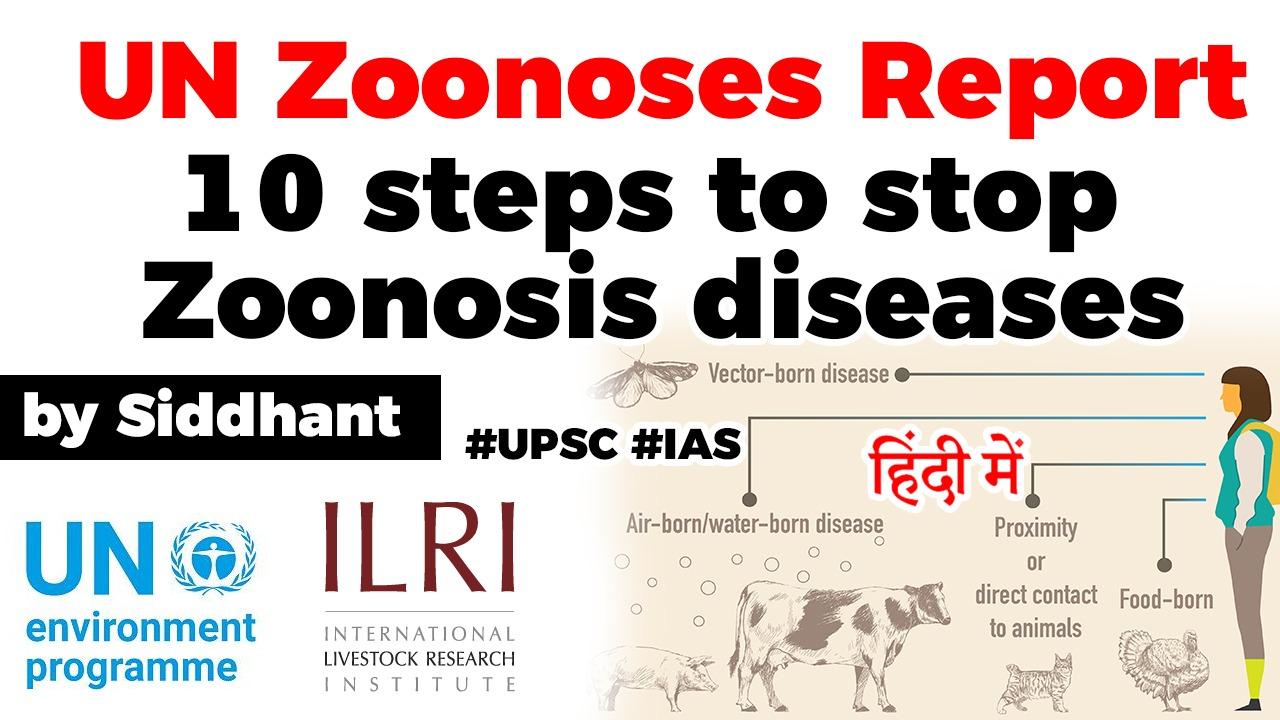Table of Contents
UN REPORT
- About 60 per cent of known infectious diseases in humans and 75 per cent of all emerging infectious diseases are zoonotic, according to a new report published recently by the United Nations Environment Programme (UNEP) and the International Livestock Research Institute (ILRI).
- Preventing the Next Pandemic: Zoonotic diseases and how to break the chain of transmission was released on July 6, 2020, celebrated as ‘World Zoonoses Day’. “It may be the worst, but it is not the first,” Inger Andersen, executive director of UNEP wrote in the foreword of the report.
ZOONITIC DISEASES
- Zoonosis or zoonotic disease is a disease that has passed into the human population from an animal source directly or through an intermediary species.
- Zoonotic infections can be bacterial, viral, or parasitic in nature, with animals playing a vital role in maintaining such infections. Examples of zoonoses include HIV-AIDS, Ebola, Lyme Disease, malaria, rabies, West Nile fever, and the current novel coronavirus disease (COVID-19) disease.
- The report discussed the context and nature of potential future zoonotic disease outbreaks, during the COVID-19 pandemic.
PROBLEMS
- Identified seven anthropogenic driving factors leading to the emergence of zoonotic diseases — increased demand for animal protein; rise in intense and unsustainable farming; the increased use and exploitation of wildlife; unsustainable utilisation of natural resources; travel and transportation, changes in food supply chains and the climate change crisis.
- The growing demand for animal-derived food has encouraged the intensification and industrialisation of animal production.
- Intensive farm settings cause them to be raised in close proximity to each other, in less ideal conditions characterised by limited biosecurity and animal husbandry, poor waste management and use of antimicrobials as substitute for these conditions.
PROBLEMS
- High use of antimicrobials in such farm settings is also contributing to the burden of antimicrobial resistance (AMR), which itself is a chronic pandemic of high cumulative damage threating public global public health.
- Moreover, loss of forest cover for agricultural purposes such as growing of soy, used as a key constituent of animal feed, is also influencing the emergence of zoonotic diseases by increasing human access to wildlife.
- The report also deciphered how human activity contributed to the emergence of diseases at the environment-wildlife interface. The increased use and exploitation of wildlife can bring humans in closer contact with wild animals, thus increasing the risk .
SOLUTIONS
- The report made ten recommendations based on the One Health approach that could aid a coordinated multi-sectoral response to future pandemics. These included:
- Raising awareness of zoonotic diseases;
- Investing in interdisciplinary approaches, including One Health;
- Expanding scientific enquiry into zoonotic diseases;
- Improving cost-benefit analyses of interventions to include full-cost accounting of societal impacts of disease;
- Strengthening monitoring and regulation practices associated with zoonotic diseases, including food systems;
- Incentivising sustainable land management practices and developing alternatives for food security and livelihoods that do not rely on the destruction of habitats and biodiversity;
SOLUTIONS
- Improving biosecurity and control, identifying key drivers of emerging diseases in animal husbandry and encouraging proven management and zoonotic disease control measures;
- Supporting the sustainable management of landscapes and seascapes that enhance sustainable co-existence of agriculture and wildlife;
- Strengthening capacities among health stakeholders in all countries; and
- Operationalising the One Health approach in land-use and sustainable development planning, implementation and monitoring, among other fields.
SOLUTIONS
- It underlined the need for strengthening the environmental dimensions of the One Health approach, since this was key to zoonoses risk reduction and control.
- We must also begin to re-think our relationship with food, how it is growna and what impacts in can have on us and our environment. It is time we opt for sustainable methods of food production and reduce dependence on intensive systems to preserve health and ecosystems.
Latest Burning Issues | Free PDF






















 WhatsApp
WhatsApp